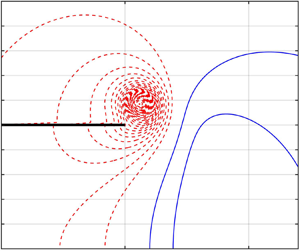Article contents
Development of the impulse and thrust for laminar starting jets with finite discharged volume
Published online by Cambridge University Press: 14 September 2020
Abstract

In order to elucidate the physical connection between the propulsive performance and the unsteadiness of jet flow, the transient development of the impulse and thrust of laminar starting jets with finite fluid discharged is investigated numerically for cases with different velocity programmes and jet stroke ratios. The simulation quantitatively demonstrates that the impulse and thrust generated are highly sensitive to the jet kinematics and its near-wake dynamics. The momentum flux contribution to the jet impulse is found to be significant and is associated closely with the jet kinematics. On the other hand, although the over pressure effect at the jet initiation stage has been identified previously as the main reason for the enhanced propulsive performance of the starting jet, the current results indicate that its contribution is in fact weakened by the negative local pressure, induced by the formation of the leading vortex ring as well as jet development during the deceleration stage. Contrary to the effects of the leading vortex ring, the stopping vortex formed near the nozzle exit plane during the jet deceleration stage is found to contribute positively to the pressure impulse production, albeit it is relatively small. By augmenting the over pressure effect and mitigating the negative-pressure effect, the cases with the fast acceleration and slow deceleration velocity programme is capable of producing the maximum pressure impulse, leading to additional impulse production over what would be expected from the jet momentum flux alone.
JFM classification
Information
- Type
- JFM Papers
- Information
- Copyright
- © The Author(s), 2020. Published by Cambridge University Press
Footnotes
Present address: AVIC Harbin Aircraft Industry Group, Harbin 150066, PR China.
References
- 19
- Cited by


